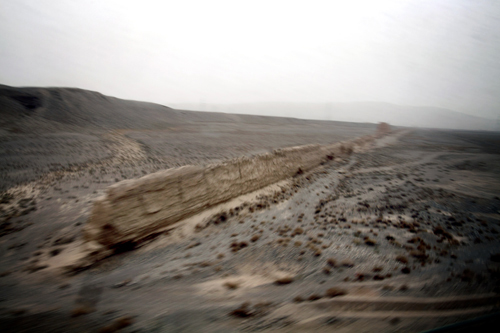
There are some places in the world where you don't want to get a flat tire: a 2 1/2-hour drive on dirt tracks into the middle of the desert, with no cell phone coverage and no hint of civilization, is one of them. So when we got our second flat tire, we started to worry a little. We were suddenly a wheel short and a long way from help.
We had come to visit the abandoned city of Yinpan, which lies approximately 300km east of the modern city of Korla in China's western Xinjiang province on the fringes of China's most formidable desert, the Taklamakan. It is estimated that nearly 40 cities have been abandoned in Northwest China as a result of desertification in the past 2,000 years. Yinpan is one of those cities and it was the next stop on my 4,000km journey across the breadth of China photographing and writing about the effects of desertification throughout the country, on assignment for the Pulitzer Center on Crisis Reporting.
Desertification is the gradual transformation of arable and habitable land into desert, usually caused by climate change and/or the destructive use of land. It is estimated that nearly 20 percent of China's land area, some 1.74 million square kilometers, is now classified as desert. Affecting the lives of an estimated 400 million people, it is the most important environmental issue in China today and arguably the most underreported. It is not a new challenge for China, however. By looking to the past, evidence of failed attempts at handling this crisis can easily be found, especially along the ancient Silk Road.
Sitting in our now three-wheel 4WD, our chances of reaching the old city of Yinpan were starting to look slim. More worryingly, our driver had just hitched a lift from a passing truck and headed back to town on a six-hour round-trip. With no way for us to contact him, or for him to contact us, our fate was in his hands. We sat, alone in the deathly silent desert. We could only do one thing. We waited.
As the red sun slowly began its descent past the horizon, my guide recounted stories of "strange" and "unexplained" things that occurred to people visiting the old city of Yinpan. "People hear strange noises around the city," he recounted. "Objects move in the night," he claimed. They were the normal superstitious tales associated with supposedly haunted places such as abandoned cities. I politely nodded my skeptical head. We were definitely having a bad run of luck though, I thought.
Any hope of a sensational "curse" story was dashed, however, when, just as the light was dying, the line of billowing dust appeared on the horizon behind a 4WD. With a big smile on his face our driver hopped out of his newly borrowed car, embraced us all and exclaimed, "This is what traveling is all about, huh?" Our relieved smiles echoed his. The next morning we finally arrived at the old city.
Situated in one of China's most remote and harshest of regions, the mysterious city of Yinpan was deemed "lost" only up until 1898, when the British archaeologist-explorer Sir Marc Aurel Stein rediscovered its location. What he found was evidence of a prosperous city of merchants and traders living in a developed site containing infrastructural components such as city walls, a garrison, Buddhist temples and living quarters capable of housing thousands of people. Stein had proved the existence of this fabled place, but like those before him, could not shed light on the reasons for its abandonment.
Approximately 2,000 years ago the city of Yinpan was a successful, thriving and eclectic city. Welcoming travelers from across Asia plying the legendary Silk Road, the city was populated by a diverse mix of ethnic groups originating from the Middle East, Mongolia and Western China. The city's exact beginnings are unclear, but what is now known is that nature and man inadvertently conspired to fuel the city's rapid demise some 1,500 years ago. Chinese archaeologists currently hypothesize that the demise of Yinpan was a result of two combined factors. The first was a change in the route of the Silk Road, taking it away from the city, hence reducing trade in and out of the area. The second factor was the drying up of the Peacock River that traditionally supplied water to the region. This reduction of water is thought to have been a result of natural environmental fluctuations; however, the inability of the people to adapt to this change led to the misuse and ultimately the complete disappearance of water.
Today, the city is but a shadow of its former self. Hundreds of years of erosion have eaten away at the abandoned structures, leaving faint indications of what was once present. The environment is assaulting the city. In the spring sandstorms batter the remaining structures, making them increasingly fragile. Then in the summer months, flash floods from mountains to the north wash away the delicate topsoil.
Sadly, little is being done to protect what is left of the old city of Yinpan. The self-governing Xinjiang Uyghur Autonomous region is less affluent than other provinces in China and has little to spare for the city's protection. The site is protected in its geography from the hoards of domestic tourists in China but it is the city's fragility against the environment that is proving to be its biggest weakness.
As desertification increases in the region and sandstorms escalate in intensity, the assault on Yinpan intensifies. The bones and belongings of former citizens of this city lie scattered around. With little to protect them and the city, a link to China's rich history in the west is slowly being wiped off the few maps where it had continued to be shown.





